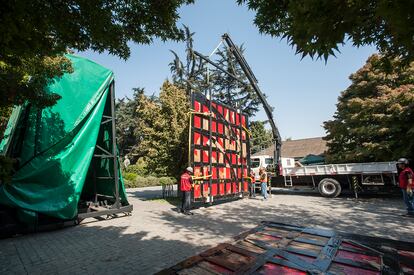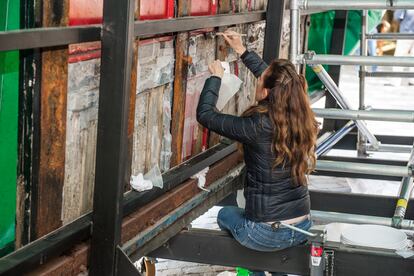How did Wembley Stadium’s original wooden gates find their way to Chile?
One hundred years after the inauguration of the ‘cathedral of football’ in London almost nothing remains of the original venue, but the doors to the tunnel are being restored in Santiago

Wembley Stadium first opened its gates to the public on April 28, 1923. The venue had a standing capacity of 125,000 spectators and was built in an area of London envisaged for family recreation and where, years earlier, an aborted attempt to rival the Eiffel Tower in Paris had been launched (the uncompleted project, known as Watkin’s Tower, had been demolished in 1907). The stadium was originally called the British Empire Exhibition Stadium and had been constructed ahead of London staging the British Empire Exhibition in 1924. It soon became known simply by the name of the suburb in which it stood: Wembley.
The first game the new stadium hosted was the FA Cup final of 1923, contested by Bolton Wanderers and West Ham. Fearing that Wembley would not be filled to the rafters for the showpiece game of the season, the authorities launched a concerted campaign for spectators to attend. In the end, 300,000 people descended on Wembley — tickets were only available on the day at the stadium. With accesses blocked, many departed but the majority forced their way into the ground, filling not only the stands but also the playing surface itself.

With the game in danger of being called off, a police officer and his horse gained immortality: Constable George Scorey and his faithful steed, Billy, performed careful circuits of the pitch to push the crowd back. Although the task appeared impossible, Scorey and Billy succeeded and, an hour after the game was scheduled to kick off, the teams emerged from the tunnel. Bolton won the game 2-0 and images of fans respectfully watching the game from the touchlines have passed into legend. The match was subsequently dubbed the “White Horse Final.”
A century has passed since that game and the “cathedral of football” as Brazilian great Pelé once described the stadium has hosted the finals of World Cup, European Championship and Champions League, with many memorable moments in soccer history unfolding on the hallowed turf. However, the building was old and no longer met modern sporting requirements, and as such it was demolished between 2002 and 2003 to make way for a new Wembley Stadium, which was inaugurated in 2007 as part of the U.K.’s preparations to host the 2012 Olympic Games. The vast majority of the old stadium was pulled down, including the famous twin towers, but its two heavy wooden gates, each weighing several tons, survived and are now in Chile.

These gates were originally known as the “gates of the royal tunnel.” George V passed through them to present the FA Cup to Bolton on that day in 1923, and Queen Elizabeth did likewise many times during her reign. The gates are, strictly speaking, square, since they measure 16 feet by 16 feet (almost five meters per side). Before the demolition of the old Wembley Stadium, they were acquired by the Brooking Trust, an architectural charity specializing in doors and windows, which tried vainly to exhibit them in a museum. The trust retained them for 11 years, but their size and weight meant that eventually, along with a handful of other relics, they were put up for auction at Sotheby’s on November 8, 2011, when Chilean businessman Jorge Yarur acquired them for just under €4,500 ($4,960).
The only son of a powerful banker, Yarur has been involved in several family disputes over inheritance but found his calling when he inaugurated the Fashion Museum, located in the old family home in the Vitacura neighborhood of Santiago de Chile, where he exhibits collections acquired from across the world. He bought Wembley’s wooden gates with the idea of them forming the star attraction at a museum of sport, a project that was eventually postponed.

The gates were transported by sea between London and the Chilean port of San Antonio, from where they traveled by truck to the museum’s warehouses. The deterioration suffered during the long voyage and their previous storage was severe and Stephen Pennec, who had previously dedicated more than a decade of his life to restoring objects recovered from the Titanic, was called in.
“We are seeking support to stage an exhibition in Europe or the United States that includes the famous Wembley gates, which are important in the history of soccer and rock music, because of the number of historic concerts that were held in the old stadium,” says Yarur. “In addition to the doors, we also have in the collection one of the circular windows from one of the two mythical towers. All the pieces in the museum are in held in perfect conservation conditions, avoiding changes in humidity and temperature.”
In sporting terms, the Chile national team have never been beaten at Wembley. In 1989 La Roja and England played out a goalless draw while Marcelo Salas led the side to a 2-0 victory in the old stadium in 1998. At the new Wembley, Chile’s top scorer of all time, Alexis Sánchez, inspired a 2-0 victory in 2013.
Sign up for our weekly newsletter to get more English-language news coverage from EL PAÍS USA Edition
Tu suscripción se está usando en otro dispositivo
¿Quieres añadir otro usuario a tu suscripción?
Si continúas leyendo en este dispositivo, no se podrá leer en el otro.
FlechaTu suscripción se está usando en otro dispositivo y solo puedes acceder a EL PAÍS desde un dispositivo a la vez.
Si quieres compartir tu cuenta, cambia tu suscripción a la modalidad Premium, así podrás añadir otro usuario. Cada uno accederá con su propia cuenta de email, lo que os permitirá personalizar vuestra experiencia en EL PAÍS.
¿Tienes una suscripción de empresa? Accede aquí para contratar más cuentas.
En el caso de no saber quién está usando tu cuenta, te recomendamos cambiar tu contraseña aquí.
Si decides continuar compartiendo tu cuenta, este mensaje se mostrará en tu dispositivo y en el de la otra persona que está usando tu cuenta de forma indefinida, afectando a tu experiencia de lectura. Puedes consultar aquí los términos y condiciones de la suscripción digital.
More information
Archived In
Últimas noticias
Maduro pleads not guilty before the federal court in New York: ‘I am still the president of Venezuela’
A new test can detect Alzheimer’s from a finger prick
UN team enters Sudanese city of El Fasher after paramilitary massacre: ‘It’s like a ghost town’
A recipe for resistance: Indigenous peoples politicize their struggles from the kitchen
Most viewed
- Gilles Lipovetsky: ‘If you want to live better and fall in love, take Prozac, don’t look to philosophy’
- Alain Aspect, Nobel laureate in physics: ‘Einstein was so smart that he would have had to recognize quantum entanglement’
- Alvin Hellerstein, a 92-year-old judge appointed by Bill Clinton, to preside over Maduro’s trial in New York
- Why oil has been at the center of Venezuela-US conflicts for decades
- Maduro’s downfall puts China’s relationship with Venezuela to the test










































